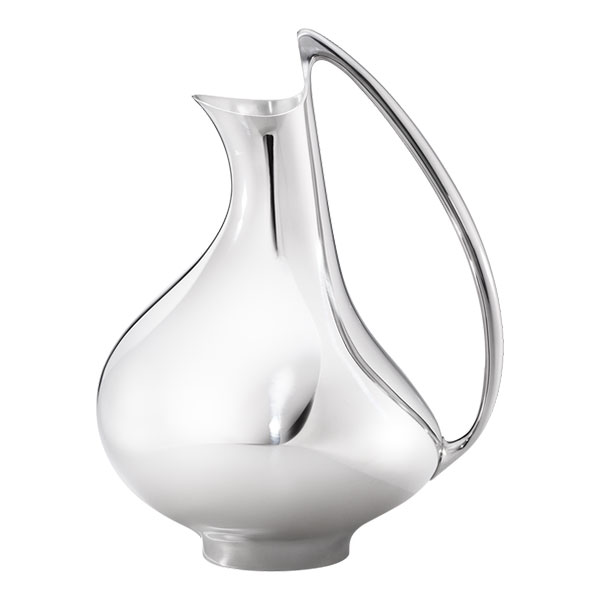
For more than a century, the Georg Jensen workshop in Copenhagen, Denmark, aka the Smithy, has produced jewelry, tableware, bar and wine accessories, cutlery, hollowware, and home decor items made of sterling silver for discerning clients worldwide. Founded by the Danish silversmith Georg Jensen in 1904, at the height of the Art Nouveau era, the company nevertheless embraces a design ethos familiar to fans of the Bauhaus, devoting equal attention to both functionality and beauty.
In addition to espousing a modernist vision that would carry his company well into the next century, Jensen was a proponent of collaboration long before it became a buzzword. Shortly after founding Georg Jensen and continuing for decades after his death in 1935, the company developed a tradition of inviting designers with a shared vision—Scandinavians Sigvard Bernadotte, Henning Koppel, and Vivianna Torun Bülow-Hübe, for example—to create collections that are available for purchase to this day.
More recently, the brand teamed up with industrial designer Marc Newson to create a limited-edition silver tea service, and architect Zaha Hadid, who, just months before her unexpected passing in 2016, designed a range of cuff bracelets and rings inspired by her Galaxy Soho complex in Beijing.
For about a dozen years, the company has occupied the former Royal Copenhagen porcelain factory in the Frederiksberg neighborhood of the capital (you can still see the furnaces through the windows on the ground floor!). On premises, about 25 silversmiths spend up to six months single-handedly soldering, hammering, and polishing silver pieces that blur the line between functional design objects and art.
Last week, I spent a few days in Copenhagen as a guest of Georg Jensen. The company unveiled a very special silver creation, which I can’t tell you anything about because the news is under embargo until mid-August. So instead I’m going to tell you a few things I learned about this fascinating legacy brand during a tour of the Smithy by Nicholas Manville, senior vice president of design.
If your travels take you to Copenhagen—after just three days there, I’m convinced it’s the coolest city in Europe—be sure to pay a visit to the Smithy (and the outlet next door!). The company wholesales its home products and retails its jewelry, so if you’ve been considering adding hollowware or tabletop to your store, think of this as a crash course in the work of one of the world’s finest makers.
Georg Jensen began his design career as a ceramicist
An artist, sculptor, and goldsmith, Jensen earned a name for himself as a ceramicist when a jug he created, called “The Maid on the Jar,” was included in the Danish exhibition at the Exposition Universelle in Paris in 1900. Propelled by that success, he turned to silver, opening a workshop on Bredgade Street in central Copenhagen in 1904. To attract customers, he set up a small showcase on the street filled with silver jewelry. Passersby who liked what they saw could order custom pieces. Two years later, at the ripe old age of 40, he moved into his own storefront—and his love affair with silver hollowware began.
Georg Jensen products span three essential design languages: Art Nouveau, Art Deco, and modern
“We have about 1,500 references today in hollowware and this is no. 2,” said Manville, as he held up the original Blossom Teapot, a stout, curvaceous little pot with distinctive toad’s feet. “What’s notable about it is that it’s an expression of Art Nouveau that is uniquely Scandinavian and uniquely Georg Jensen. You’ve seen a lot of other Art Nouveau pieces that are quite complicated with a lot of embellishment, and this is the Scandinavian way, with references to nature that are simple and humble.”
“You have plant life represented by the flower,” he continued, pointing to the magnolia blossom on the top. “You have the tail of a bird expressed in the handle. And you also have hammer marks. Hammer marks are a unique part of what the house does. A lot of people at the time were polishing out the hammer marks to make the surface completely smooth, but in Jensen’s world, the hammer marks are almost a reference to the hand of ceramics, and to Scandinavian light. The idea is to absorb light and create a glow, not to reflect light. This hammer mark almost gives the pieces a little bit of a soul as opposed to bling.”
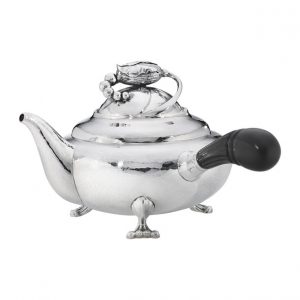
The handle of the original Blossom Teapot was made with ivory. Today, it’s made with ebony (photo courtesy Georg Jensen).
In the 1920s, the company, moved into the Art Deco period thanks in part to the work of designer Harald Nielsen, who designed a cutlery pattern in 1926 called Pyramid, a reference to the Egyptian revival inspired by the 1922 discovery of King Tut’s tomb.
“We still see some softness, but we’re getting into some stricter lines,” Manville said.
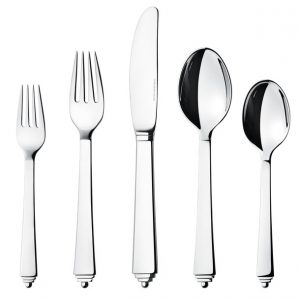
Georg Jensen owes the Pyramid design to Harald Nielsen, who arrived at the Smithy as an apprentice as early as 1909 (photo courtesy Georg Jensen).
As a brand, however, Georg Jensen may best be known for the unforgettable work created by its cohort of modernist designers such as Henning Koppel, whose creations—like the curvaceous Pregnant Duck pitcher (design No. 992 in the company’s vast archives)—are beloved by both longtime Georg Jensen collectors and those just getting introduced to its oeuvre.
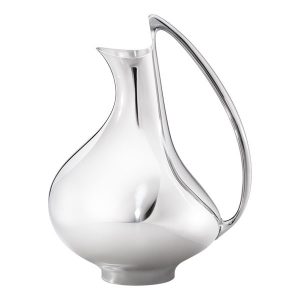
Modernist Danish designer Henning Koppel conceived Pitcher No. 992, aka the Pregnant Duck, an icon of 20th century design (photo courtesy Georg Jensen).
The brand excels not only in the production of silver objects, but also in steel
During the war, Georg Jensen began to experiment with metals beyond silver, including stainless steel. “Over the years, we developed high polish steel,” Manville said. “We find it to be almost a noble material. We work with a different, thicker gauge. It’s a handmade product even though it’s steel and feels very industrial.”
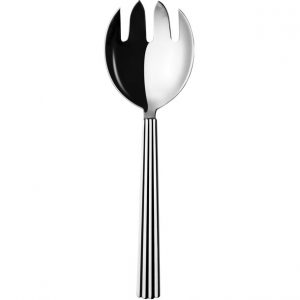
Consider this Bernadotte serving fork in steel, by Sigvard Bernadotte, a Swedish prince whose work with the brand throughout the 20th century remains highly sought after (photo courtesy Georg Jensen).
The most important silver hollowware pieces are made by one person from start to finish—over the course of months
On our tour of the Smithy, we were introduced to a handsome young silversmith named Andreas, who was busy making an African Lady Pitcher, another iconic Koppel design. The process, Manville said, is “almost like preparing a recipe.”
“You start by pulling out all the tools you need to make it,” he said. “A lot of the tools are over 100 years old. They’re crafted specifically for pieces, and they’re all numbered. So Andreas knows if he’s going to make the neck of this pitcher, he’ll need hammer number 57. If someone makes a piece, a lot of times they’ll make their own handle for it because there’s such repetition in the hammering, it has to be comfortable for you. You also need to take breaks from it. Part of the time we talk about making a silver piece like that includes time away from it. Because you need to come back to it. You have to take a break to come back and make sure you’re doing all this correctly. Because for six months of work, it can become all-consuming.”
To understand Georg Jensen’s jewelry, remember these three iconic designs
Our tour of the Smithy focused on the brand’s mastery of hollowware, but don’t forget that Georg Jensen founded his company with a jewelry showcase—and the company never lost that thread.
Among the brand’s most famous collaborators was Vivianna Torun Bülow-Hübe, a Swedish designer whose minimalist Torun bangle I spied on more than a few wrists in Copenhagen.
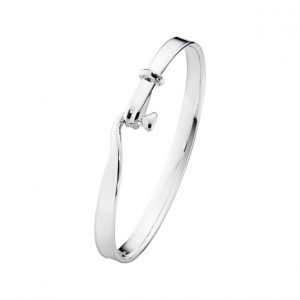
The Torun bangle in sterling silver
She also created the Vivianna Bangle watch, a response to being told to design a timepiece, something she hated, according to Manville. “She hated the idea of keeping track of time so she designed an unconnected bangle—so you’re not restricted by time,” he said.
Famed for its mirror image—“So you can see yourself reflected,” Manville said—the watch was designed to liberate “the wearer from the convention of time.”
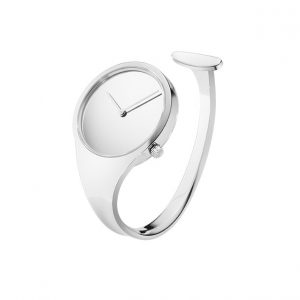
The Vivianna Bangle watch with a mirror dial
The Fusion ring completes the Georg Jensen jewelry trinity. Designed by Henning Koppel’s daughter, Nina Koppel, before she died in 1990, the ring now exists in myriad iterations, including the chic rose gold and diamond-set style below.
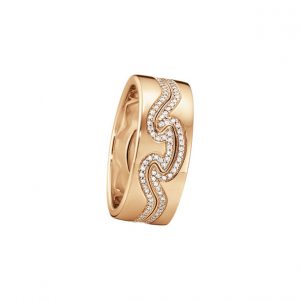
The two-piece Fusion ring in 18k rose gold with brilliant-cut diamonds
There is so much more to say about Georg Jensen. Especially after mid-August, when I can reveal the news about the company’s latest masterpiece. Watch this space!
- Subscribe to the JCK News Daily
- Subscribe to the JCK Special Report
- Follow JCK on Instagram: @jckmagazine
- Follow JCK on X: @jckmagazine
- Follow JCK on Facebook: @jckmagazine